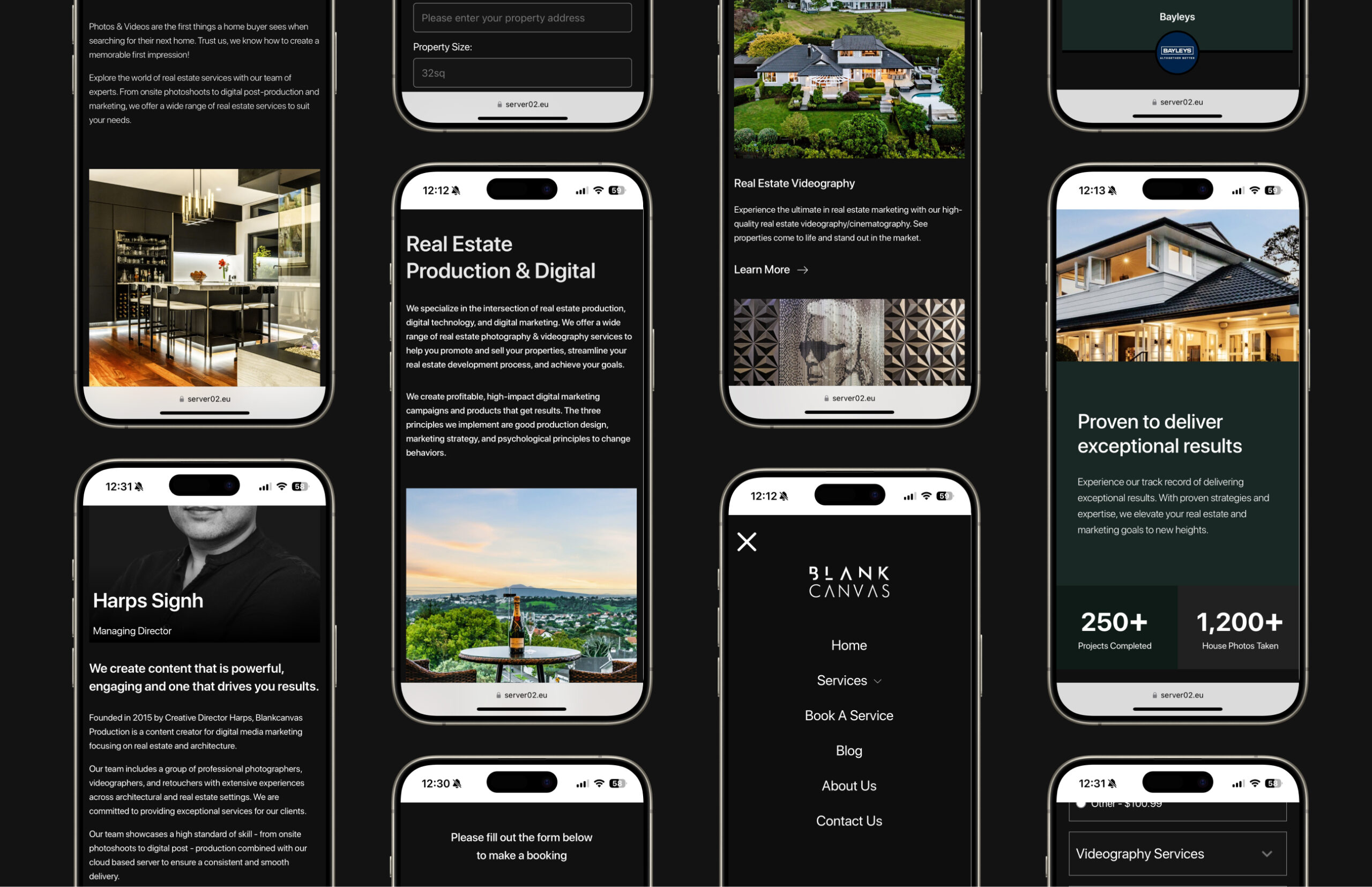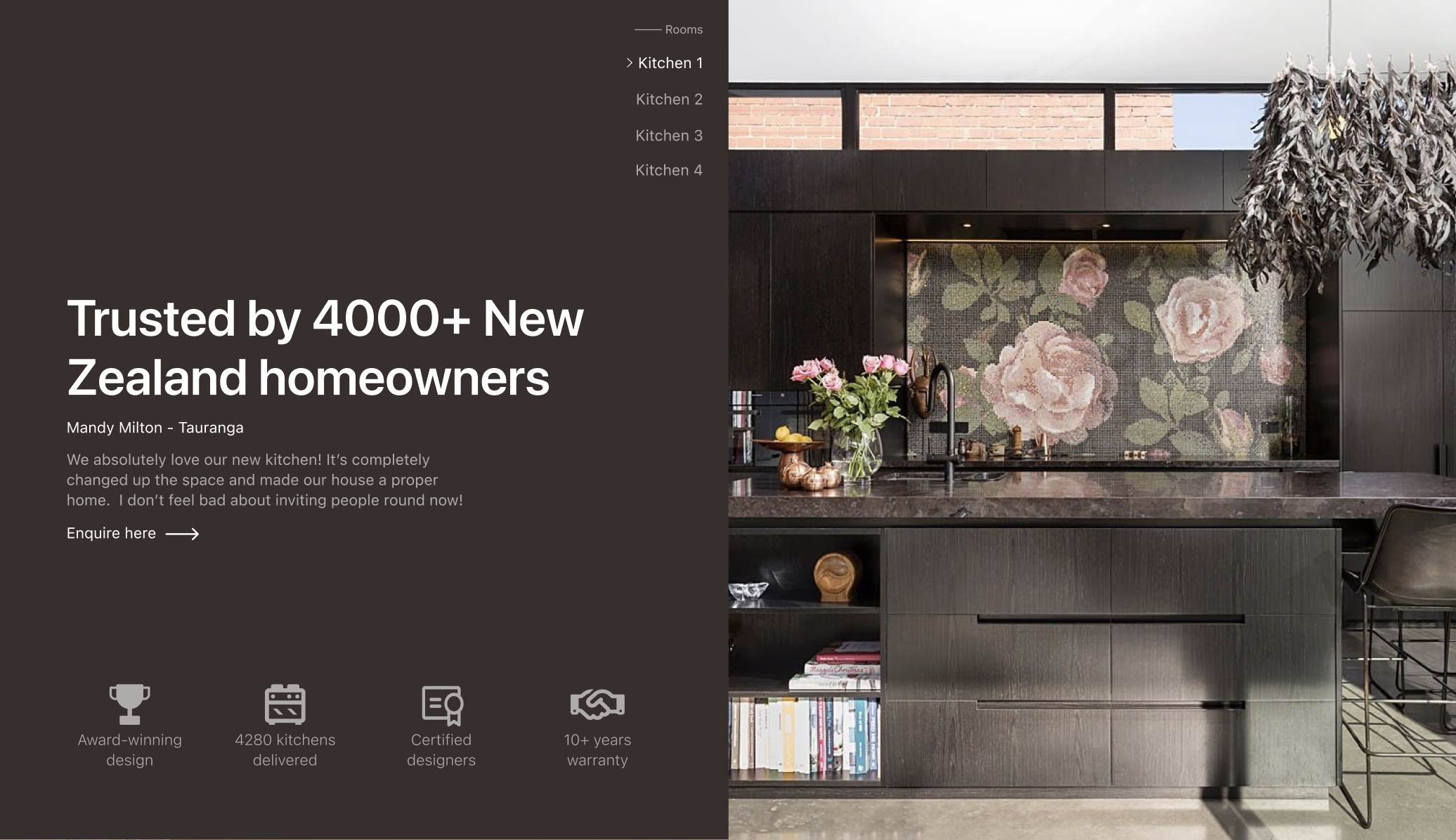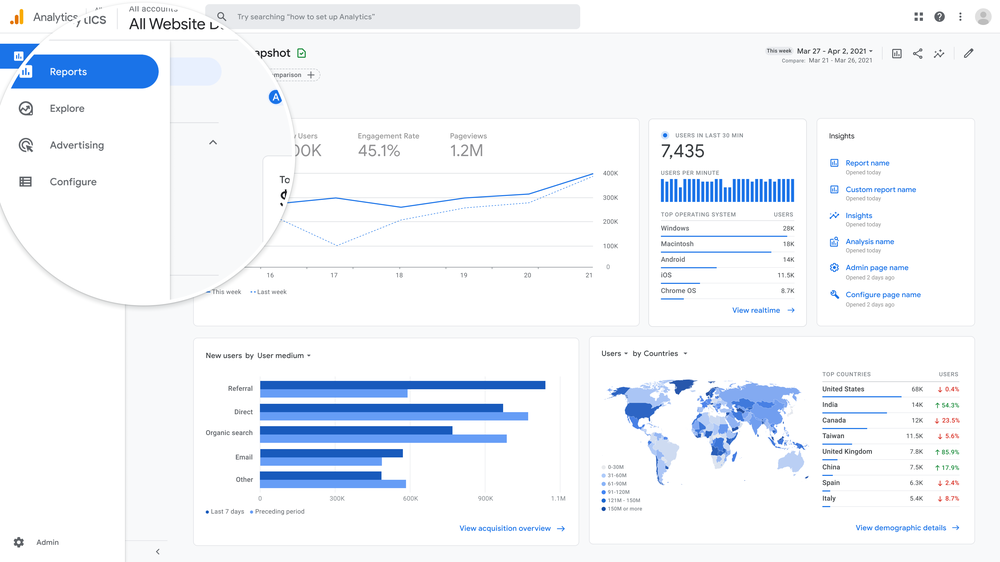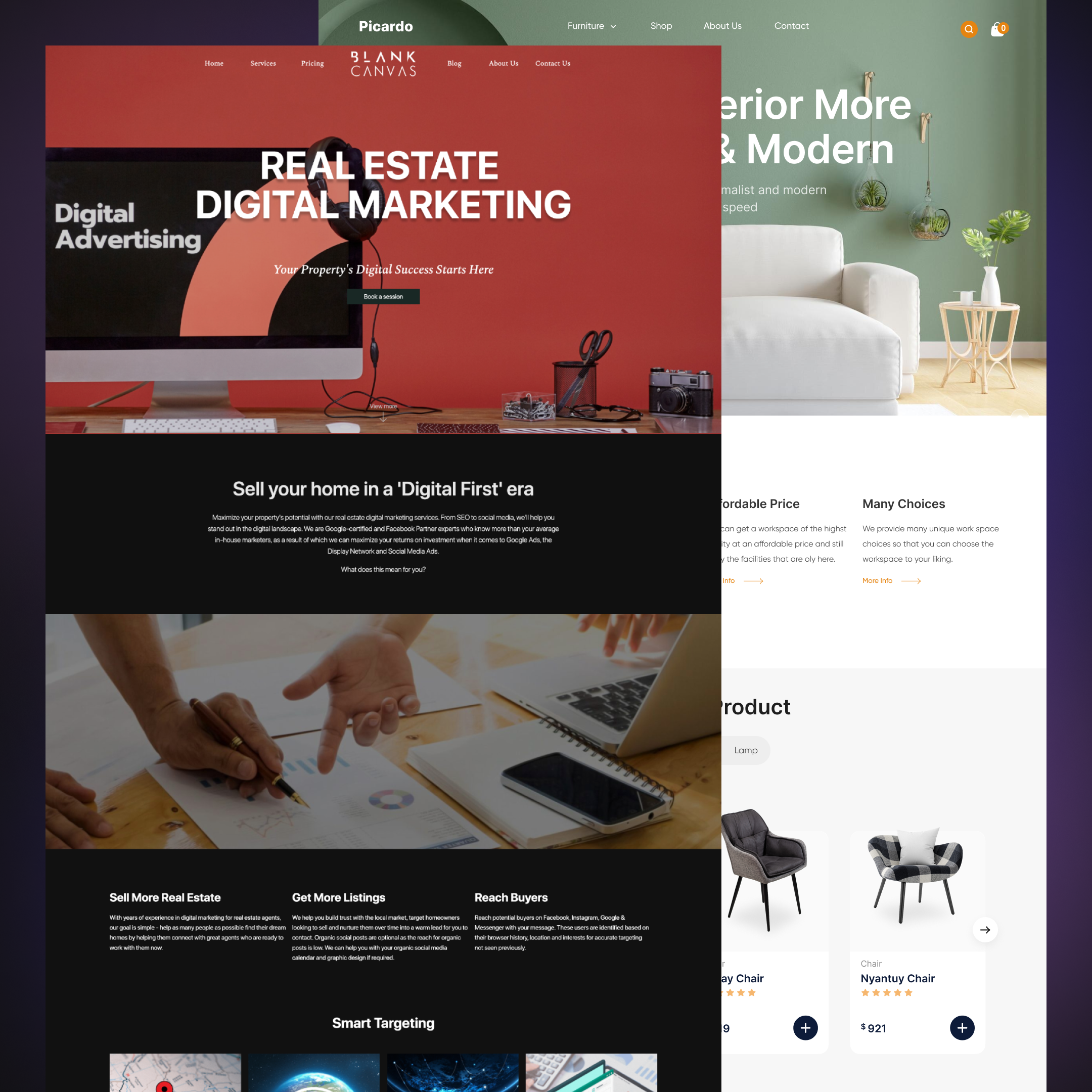Building a standout real estate agent website isn’t just a task – it’s a must-do if you’re serious about thriving in this industry and selling property online. Your website is your handshake, your introduction, an online presence, and your first pitch to potential clients. Get it right, and you’ll create more than just an online space – you’ll establish a lead-generating, trust-building powerhouse. Let’s break down exactly how to create a site that doesn’t just exist but commands attention.
Intuitive Navigation for Seamless User Experience
Why This Is Important
Navigation is the backbone of any user experience. If visitors can’t find what they’re looking for quickly, they’ll leave. This is especially true for real estate and real estate agencies, where potential clients are searching for specific properties or information. A site that guides users intuitively can through website development makes the difference between a casual visitor and a serious lead.
What It Looks Like
An effective navigation bar should be straightforward and include key sections like “Home,” “Property Listings,” “About Us,” and “Contact.” An advanced search tool with filters like location, price, and property type takes navigation to the next level, making it easier for users to zero in on what they need.
Clear and Logical Menu Structure
The menu should be well-organised, easy to read, and available across all devices. Label your sections in a way that feels familiar to your audience, like using “Find a Home” instead of technical jargon. Consistency here helps visitors build trust in your site’s usability.
Advanced Search Tools
Advanced search functionality is crucial. Allow users to filter listings by criteria such as neighborhood, property type, and price. This isn’t just a convenience – it’s an essential web development tool that keeps users on your site longer, engaged, and more likely to take action.
Mobile-First Navigation
Your navigation needs to work seamlessly on mobile. That means having collapsible menus, clickable elements sized for fingertips, and fast load times. A good mobile experience keeps users exploring your site, even on the go.
Responsive Web Design for Mobile Users
Why This Is Important
We’re in an era where mobile browsing dominates. A website that doesn’t perform well on mobile is a missed opportunity for engagement and leads. Responsive design ensures that your site looks and works beautifully across any device, enhancing user experience and boosting your search engine optimisation (SEO).
What It Looks Like
A responsive design means that whether someone is browsing your site on a smartphone, tablet, or desktop, the layout adapts fluidly to fit the screen size. This isn’t just about resizing images; it’s about ensuring every element – text, buttons, and navigation – functions perfectly, no matter the device.
Importance of Mobile Optimisation
Sites optimised for mobile provide a seamless experience that keeps visitors engaged. Google also ranks mobile-friendly sites higher, so it’s a crucial factor for your visibility and user satisfaction.
Optimised Image and Media Loading
Make sure that images and videos are compressed and optimised for fast loading on mobile devices. Users won’t wait for slow-loading media, so performance enhancements are a must for keeping them engaged.
Adaptive Content Layouts
Responsive design should extend to the layout of your content. Keep text sizes readable, images proportional, and ensure buttons are easily tappable on touchscreens.

High-Quality Visuals to Showcase Listings
Why This Is Important
When it comes to real estate, visuals aren’t just supplementary; they’re essential. High-quality images and videos can draw a user’s attention, convey the atmosphere of a property, and make listings stand out. Poor-quality visuals can undermine trust and interest in seconds.
What It Looks Like
Imagine browsing a site and finding beautifully shot, high-resolution images of properties, coupled with video tours and 360-degree views that let you explore each room. These visuals should be captivating enough to make potential clients imagine themselves in the space.
Using High-Resolution Images
Invest in professional photography that showcases properties with the best angles and lighting. These images should load quickly without sacrificing quality, so optimising them for web use is key.
Video Tours and 360-Degree Viewings
Virtual tours are a game changer. They offer an immersive experience that static images can’t. With the convenience of a video or 360-degree view, potential clients can “walk through” a property and get a feel for the space without ever leaving their home.
Drone Footage for Unique Perspectives
For properties with extensive yards, large plots, or stunning views, drone footage video functionality can be a standout feature. It provides a perspective that ground-level photos can’t, making your listings even more appealing.
Compelling Call-to-Actions (CTAs)
Why This Is Important
A beautifully designed website is wasted if your target audience don’t know what to do next. That’s where CTAs come in. They guide users toward actions that benefit both them and your business, whether that’s scheduling a viewing, signing up for a newsletter, or contacting you directly. Effective CTAs can increase conversions and turn casual visitors into qualified leads.
What It Looks Like
CTAs should be strategically placed, clear, and action-oriented. Phrases like “Schedule a Viewing” or “Get Your Free Appraisal” make it easy for users to know what the next step is. Good CTAs are visible without being intrusive and encourage interaction without pressuring the visitor.
Strategic CTA Placement
Place CTAs in locations that align with user decision-making points, like at the end of property listings or within your homepage banner. A CTA next to a glowing testimonial or a particularly appealing property image can nudge users to take action.
Lead Capture Forms
Ensure that lead capture forms are easy to complete and don’t overwhelm the user with too many fields. The easier it is for someone to fill out your form, the more likely they are to do so. Use forms for scheduling viewings to open homes, requesting property details, or signing up for alerts on new listings.
A/B Testing for Effectiveness
Not sure if your CTA is effective? Test it. Run A/B tests on different wording, colours, and placements across different web pages to see which combination leads to higher engagement and conversions. Use these insights to continuously refine your approach and keep your site as effective as possible.
Optimised for SEO and Local SEO
Why This Is Important
Your website could have all the bells and whistles, but without SEO, it’s like shouting into the void. Search engine optimisation ensures your site shows up when people search for real estate services. The added layer of local SEO is crucial for real estate agents – it’s what puts your business on the radar of potential buyers and sellers in your area. SEO isn’t just a strategy; it’s the secret weapon that gets eyes on your listings.
What It Looks Like
An SEO-optimised real estate website should focus on specific keywords that reflect what your audience is searching for. This includes terms like “real estate agent in Tauranga” or “homes for sale in Auckland.” By creating location-specific landing pages, you’re making it easy for search engines to recognise your relevance to these areas, helping your site climb the rankings.
Real Estate-Specific Keywords
Your content should incorporate terms that align with real search habits. Think beyond just “homes for sale” and consider phrases like “luxury homes in Rotorua” or “affordable properties in Melbourne.” The right keyword strategy can make the difference between being on page one or lost in the search abyss.
Location-Based Landing Pages
Create landing pages tailored for the specific neighborhoods and regions you cover. These pages should highlight what makes each location unique – schools, parks, amenities, and lifestyle perks. Not only does this boost your local SEO, but it also provides valuable, relevant content for visitors who are researching where they want to live.
Structured Data and Meta Tags
Implement structured data markup (schema) to enhance how your pages are displayed in search results. Rich snippets that show images, ratings, or quick info directly on the results page can dramatically increase click-through rates. Proper meta tags and descriptions also play their part in making your site more appealing when it shows up on a search results page.
Highlight Client Testimonials and Reviews
Why This Is Important
In an industry built on trust and reputation, testimonials aren’t just nice to have – they’re essential. Social proof through client reviews helps potential clients decide if you’re the right agent for them and gives insight into your sales process. It’s like having your past clients speak up for you, reassuring new ones that you’re highly recommended.
What It Looks Like
Position client testimonials on pages where potential clients are making decisions – your homepage, service pages, and even next to CTAs. This validation from past clients gives new visitors confidence in your abilities. You can amplify this effect by including photos or video testimonials, which add a layer of authenticity that text alone can’t achieve.
Placement of Reviews
Strategic placement is key. Don’t bury your testimonials at the bottom of a page where no one will see them. Place them near CTAs or at the end of property descriptions to reinforce the positive user experience.
Case Studies and Success Stories
Take testimonials a step further by featuring case studies that detail successful transactions. Highlight a specific client’s journey, from initial contact to closing, showing your problem-solving skills and ability to deliver results. These stories paint a fuller picture of what it’s like to work with you and can be incredibly persuasive.

Interactive Elements for Added Value
Why This Is Important
Interactive elements make your website more than just a catalog of listings – they transform it into a useful tool that keeps visitors engaged. These elements provide value by answering questions or offering calculations right on the site, which keeps users from bouncing away to look for these tools elsewhere.
What It Looks Like
Include features like mortgage calculators and affordability checkers to add practical value to your site. These tools help visitors figure out their budget, making them more likely to stay and explore listings. Live chat functions can provide instant responses to questions, offering a real-time connection that can lead to inquiries or bookings.
Mortgage Calculators and Tools
A well-placed mortgage calculator can be a game changer. It gives users insight into what they can afford and encourages them to take the next step, like contacting you for a showing or financial advice. It also pre-qualifies potential customers, cutting out ones who may be wasting your time.
Live Chat Integration
Integrating live chat support ensures that potential clients get answers quickly. It can be automated to handle common queries or managed in real time for more personalised interactions. This not only keeps users engaged but also positions your site as a comprehensive service point.
Live Chat functions are also improving dramatically with the release of A.I and can be trained to perform more complex tasks such as booking open home viewings, recommending property listings, and registering sellers information for you to contact.
Educational Blog and Resources
Why This Is Important
An educational blog turns your website into a hub of useful information, boosting your credibility and encouraging visitors to return. It positions you as an expert and provides SEO benefits through regular content updates.
What It Looks Like
A robust blog should cover topics that cater to your audience’s questions and interests, such as “Tips for First-Time Homebuyers” or “Navigating the Local Real Estate Market.” This doesn’t just inform your clients; it draws in organic traffic from your target audience searching for that very information.
Content Strategy for Engagement
Plan a content calendar that focuses on different stages of the buyer’s journey. Cover everything from preparing to buy or sell a home to investment tips and market forecasts. This variety ensures that your content stays fresh and appeals to a wide range of visitors. You could even include downloadable assets such as sale and purchase agreements.
SEO Benefits of Regular Updates
A regularly updated blog signals to search engines that your site is active and relevant, which can help improve your rankings. Make sure to include keywords naturally and provide comprehensive, engaging content that keeps readers on the page longer.
Consistent Branding and Visual Appeal
Why This Is Important
Your website needs to be memorable, and consistent branding is what makes it stick. When visitors land on your site, they should immediately recognise your brand, from the colour scheme to the logo placement. Consistency instills confidence and enhances the overall user experience.
What It Looks Like
A cohesive design means using the same fonts, colours, and styles across your site. Your logo should be prominently displayed and clickable, taking users back to the homepage. This not only looks professional but also enhances navigation. It might pay to check out a custom website design over a website builder or template design!
Cohesive Design Elements
Ensure that every part of your site follows the same visual guidelines. If your brand uses blue and white, for instance, don’t introduce random colours that clash. This uniformity extends to typography, button styles, and even the way your listings are presented.
Logo Placement and Linking
A simple tip that goes a long way: have your logo at the top of each page and make it clickable. This not only helps with navigation but also reinforces your branding every time someone sees it.

Easy-to-Use Backend for Content Management
Why This Is Important
An easy-to-use backend means you or your team can update property listings, blog posts, and other essential content without needing to bring in a developer for every change. This flexibility keeps your site current and relevant, which is crucial for user trust and SEO.
What It Looks Like
Choose a CMS that allows you to add and modify content easily. It should also be powerful enough to handle custom plugins that fit the unique needs of a real estate business, such as property databases and CRM integration.
Choosing the Right CMS
WordPress is often the go-to choice for real estate websites due to its user-friendly interface and ability to host powerful plugins. But don’t stop there – make sure the CMS you choose can integrate seamlessly with your existing tools and processes. We’d recommend looking at open source CMS software to avoid being locked into any one agency with a huge cost to edit or replace it!
Integration with CRM and Property Databases
Ensure that your CMS can integrate with the CRM systems and property databases you use. This streamlines data entry and keeps your listings up-to-date without doubling the work, saving you valuable time and reducing errors.
Performance Tracking for Continuous Improvement
Why This Is Important
Once your site is live, the work isn’t over. Performance tracking helps you understand what’s working and what needs improvement. With the right data, you can make informed tweaks to keep your site performing at its best.
What It Looks Like
Set up tools like Google Analytics to monitor user behavior, traffic sources, and conversion rates. This data is invaluable for understanding how visitors interact with your site and which pages need optimisation.
Google Analytics Integration
Google Analytics can show you key metrics like average time on page, bounce rates, and user flow. These insights help you identify weak points in your site’s design or content strategy.
A/B Testing for Continuous Optimisation
Use A/B testing to refine your CTAs, landing pages, and content layouts. Even small changes can lead to higher engagement and more conversions. The data you collect from these tests should guide your ongoing website updates to keep everything fresh and effective.

Final Thoughts
A well-crafted real estate website isn’t just about looking good it’s about functioning as an effective tool that grows your business. By focusing on intuitive design, SEO, client testimonials, interactive elements, and ongoing performance tracking, you can create a site that doesn’t just compete but dominates.
Take these strategies to heart, and you’ll turn your website into a lead-generating, client-impressing machine that stands the test of time. Want to create a website for your real estate brand today? Builtflat has worked with real estate agencies and agents across New Zealand to help them sell online, get in touch to find out more!
